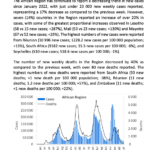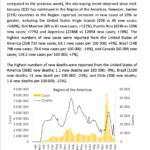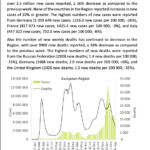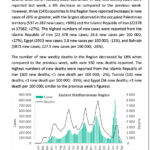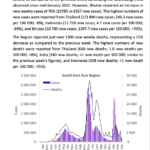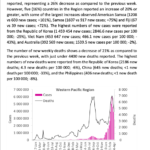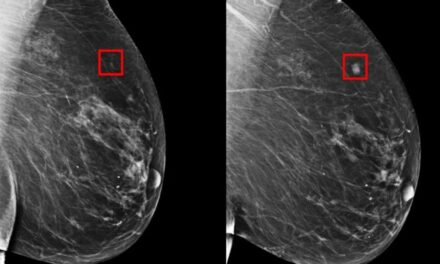Overview
Globally, during the week of 4 through 10 April 2022, the number of new COVID-19 cases has continued to decline for the third consecutive week, with a 24% decrease as compared to the previous week. Also, the number of new weekly deaths continues the decreasing trend (-18% as compared to the previous week).
Across the six WHO regions, over 7 million cases and over 22 000 deaths were reported, with all the regions showing decreasing trends both in the number of new weekly cases and new weekly deaths.
As of 10 April 2022, over 496 million confirmed cases and over 6 million deaths have been reported globally.
In this edition we provide:
- Special Focus: Update on WHO COVID-19 global rapid risk assessment
- Updates on circulating SARS-CoV-2 variants of concern (VOCs), including information on Omicron descendent lineages.
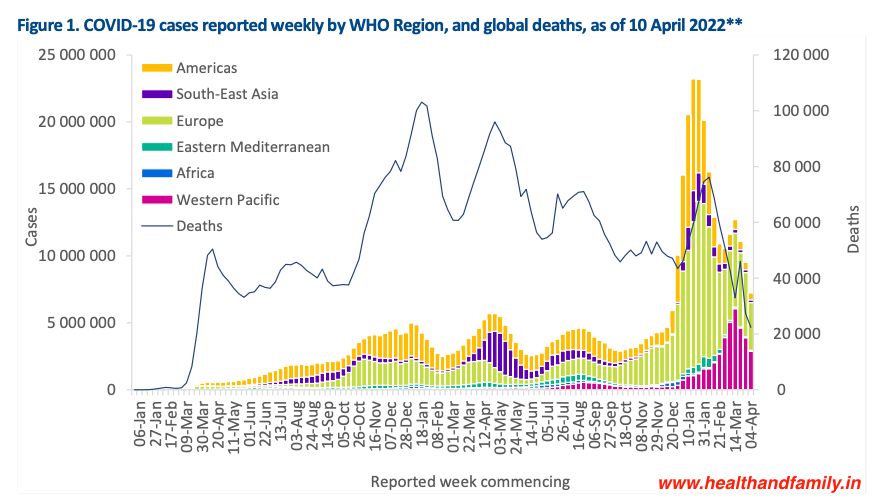
At the country level, the highest numbers of new weekly cases were reported from the Republic of Korea (1 459 454 new cases; -29%), Germany (1 019 649 new cases; -26%), France (927 073 new cases; -3%), Viet Nam (453 647 new cases; -43%), and Italy (447 322 new cases; -8%).
The highest numbers of new weekly deaths were reported from the United States of America (3 682 new deaths; -9%), the Republic of Korea (2 186 new deaths; -6%), the Russian Federation (2 008 new deaths; -15%), Germany (1 686 new deaths; +6%), and Brazil (1 120 new deaths; -22%).
Special Focus: Update on SARS-CoV-2 variants of interest and variants of concern
WHO, in collaboration with national authorities, institutions and researchers, routinely assesses if variants of SARS- CoV-2 alter transmission or disease characteristics, or impact the effectiveness of vaccines, therapeutics, diagnostics or public health and social measures (PHSM) applied to control disease spread. Potential variants of concern (VOCs), variants of interest (VOIs) or variants under monitoring (VUMs) are regularly assessed based on the risk posed to global public health.
The classifications of variants will be revised to reflect the continuous evolution of circulating variants and their changing epidemiology. Criteria for variant classification, and the current lists of VOCs, VOIs and VUMs, are available on the WHO Tracking SARS-CoV-2 variants website. National authorities may choose to designate other variants and are encouraged to investigate and report on the impacts of these variants. When referring to the genomic sequence of SARS-CoV-2 identified from the first cases (December 2019), the term ‘index virus’ should be used.
Geographic spread and prevalence of VOCs
The Omicron variant remains the dominant variant circulating globally, accounting for nearly all sequences recently reported to GISAID. Among the 379 278 sequences uploaded to GISAID with specimens collected in the last 30 daysi, 376 082 (99.2%) were Omicron, 125 (<0.1%) were Delta and 2 961 (0.8%) sequences were not assigned to a Pango lineage. These trends should be interpreted with due consideration of the limitations of surveillance systems, including differences in sequencing capacity and sampling strategies between countries, as well as laboratory turn- around times for sequencing and delays in reporting.
Omicron VOC
WHO continues to monitor several descendent lineages under the Omicron VOC, including BA.1, BA.2, BA.3 as well as now BA.4 and BA.5 . It also includes BA.1/BA.2 circulating recombinant forms, such as XE. The full list can be found here https://cov-lineages.org/lineage_list.html
A small number of sequences of BA.4 and BA.5 descendent lineages have now been detected in a few countries. Both have additional mutations in the Spike region (S:L452R, S:F486V) and unique mutations outside of Spike. The S:L452R and S:F486V mutations are associated with potential immune escape characteristics. In addition, the majority of BA.4 and BA.5 sequences have the 69-70 deletion responsible for S gene target failure (SGTF) in some PCR assays. This may prove useful for surveillance purposes in places where BA.2 is dominant, as the 69-70 deletion is largely not present in BA.2 sequences.
WHO is working with scientists to further assess the characteristics of these lineages and their public health implications. WHO recommends countries to continue surveillance, where possible, and rapid data sharing on publicly available databases.

